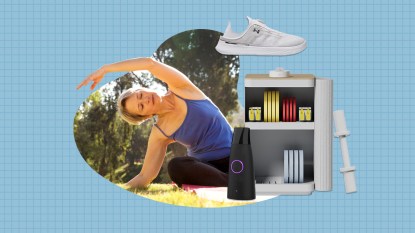Have You Fallen for These 6 Fitness Myths?
Know your fitness facts.

Given our modern era of social media influencers and unofficial fitness “experts,” it’s not surprising that so many falsehoods about exercise persist. No matter how many researchers publish good studies debunking these myths, a fair number of people still believe you’ll always lose more weight by exercising at a lower intensity, or that working out first thing in the morning is vastly superior to sweating it out any other time of the day. When everything appears so confusing, contradictory, or complex, it can seem easier to not even bother working out. But don’t despair: With the help of real fitness experts and scientific research, we’ve busted six common exercise myths. With these facts, you can be more confident about your workouts and get fitter faster.
Myth #1: You should exercise in the fat-burning zone if you want to lose weight.
Your body taps into different primary sources of energy when you exercise at certain heart rates. During higher-intensity workouts, your body burns more carbohydrates than fat. During lower-intensity workouts, it burns more fat than carbs. So, if you’re trying to shed pounds, some say it’s best to work out in the “fat-burning zone.”
First, this zone isn’t the same for everyone. A 2009 study found that there’s too much variability among individuals to accurately calculate a fat-burning zone outside of a lab setting. And if you ask several fitness experts, each will identify different target heart rates (such as 50 to 65 percent or 70 to 80 percent of your maximum heart rate) as the fat-burning zone.
Second, even if you could properly gauge your “fat-burning zone” on your own, weight loss comes down to burning more calories (and eating fewer as well). Compared to easier workouts, higher-intensity exercise torches more calories both during and after as your body recovers. You may even burn more calories in less time. And that’s what matters if you’re trying to shed pounds, says trainer Chris Gagliardi, CSCS, the scientific education content manager for the American Council on Exercise (ACE). Many studies have shown that people (usually those who are overweight) who do high-intensity interval training (HIIT) burn a similar amount of fat — in less time — than those doing more moderate sessions.
Myth #2: It’s better to exercise in the morning than at other times.
If you’re not getting up first thing and sweating, some experts believe you’re short-changing yourself. Of course, there are some benefits to this. For one, it pretty much guarantees that you’ll get a session in, rather than getting tied up at work or needing to address a family emergency and never making it to the gym later in the day. For another, some find that starting the day with a good sweat puts them in a great mindset to face whatever arises. Maybe it’s because workouts help dampen stress or because that kick-butt kickboxing class makes you feel like nothing can stop you, not even your overflowing inbox.
However, there’s no single “best” time to exercise for everyone. A research analysis of 11 studies, published in Chronobiology International, found that people who did resistance training in the morning or evening showed similar increases in strength (although strength tended to be greater in the evening). Another review found different benefits for doing strength training or cardio exercise at various times of the day. In other words, “there’s not enough evidence saying you should always work out in the morning,” Gagliardi explains. “It’s about when you’re most likely to do it and how you feel afterward.” Find what works best for you, which may mean different times on different days.
Myth #3: Working out on an empty stomach burns more fat.
Some research suggests that doing cardio or resistance training when fasted (like in the morning) may cause your body to turn to fat rather than carbohydrates for fuel. However, research has also found no difference in the number of calories burned during fasted versus nonfasted resistance training. So, as with exercising in the fat-burning zone, it may not pay off in terms of the number on the scale.
Additionally, going into your workout hungry may have negative effects, depending on your activity. If you’re doing endurance or high-intensity training, your performance may suffer (in which case you’ll definitely burn fewer calories). Some experts also theorize that your body may use more protein for fuel in this condition. This leaves less protein to repair and build muscle tissue after your workout.
It’s fairly common sense, but experts suggest that if you’re doing a shorter, less-intense workout and feel fine without eating for four or more hours beforehand, do so. But if you’re going for a long run or a HIIT class, the risk of crashing — and therefore missing out on the maximum strength-gaining and calorie-burning benefits — is probably not worth it.
Myth #4: You can’t get strong doing high reps with low weight.
Performing more repetitions with lighter weights is usually associated with increasing muscle endurance. However, it can also lead to strength gains when done properly. In a 2016 study published in the Journal of Applied Physiology, researchers split 49 men who had experience with weight training into two groups. For 12 weeks, they trained four days a week doing the same exercises. The high-rep group did three sets of 20 to 25 reps using 30 to 50 percent of their one-rep max, while the low-rep group did three sets of eight to 12 reps using 75 to 90 percent of their one-rep max. (Your one-rep max is the heaviest weight you can lift to do a single repetition of an exercise.) At the end of the study, both groups increased lean muscle mass and strength.
Other studies on untrained men found the same thing. A high-rep, low-weight training program leads to similar muscle gains as a low-rep, high-weight protocol. The secret: Lifting to failure, Gagliardi says. Every set, keep doing reps until you truly cannot do one more with good form.
Myth #5: You should work your abs every day.
Yes, your abs are important, in part because they help with both stability and mobility. But they’re like any muscle. “Do you work your legs every day? No, you take two to three days to recover between workouts so you have better results,” explains New York City-based health and wellness expert Mike Clancy, CSCS. You should also take time off between ab sessions. Even if your goal is a six-pack, “abs are not developed just by working your abs,” Clancy says. “If your goal is muscle definition, that comes from fat loss, and fat loss comes from an energy deficit.”
That said, since your entire core (abs, back, and glutes) stabilizes the body, doing almost any activity uses them to some extent. But if you’re doing actual ab-specific exercises, it’s best to hit them no more than three nonconsecutive days a week.
Myth #6: “Muscle confusion” gives you a better workout.
The theory of “muscle confusion” is that mixing up your workouts from day to day keeps your body guessing. Otherwise, your muscles adapt to the exercises and your efforts to build muscle or lose fat will plateau. But the research on this concept is mixed.
It appears that it’s best to have at least some structure to a fitness program. For example, in a 2014 study published in the Journal of Strength and Conditioning Research, men followed one of five training programs: varied exercises of constant intensity; varied exercises of varied intensity; constant exercises of constant intensity; constant exercises of varied intensity; or a control plan. After 12 weeks, the men who did varied exercises at constant intensity had greater strength gains, compared to the others.
Similarly, in another study of 21 men published in PLOS One in 2019, the “muscle confusion” group actually followed a strategic plan: The “randomly chosen” exercises that they performed during each upper-and lower-body workout were selected to evenly target their muscles so that they worked both the front and back of their bodies. Compared to another group who did the same exercises each workout, but who increased their intensity over time, this “randomized” group made similar gains in strength after eight weeks, but were more motivated to train.
So the biggest benefit of muscle confusion may be that the novelty keeps you interested, so you stick with it. “You need strategic adjustment to exercise,” Clancy states. Exercises are a bit like skills for the body to learn. Doing them with a plan that allows you to perfect the movement and then gradually add load will boost performance and strength.
This content is not a substitute for professional medical advice or diagnosis. Always consult your physician before pursuing any treatment plan.
A version of this article appeared in our partner magazine Get In Shape: 2022.













